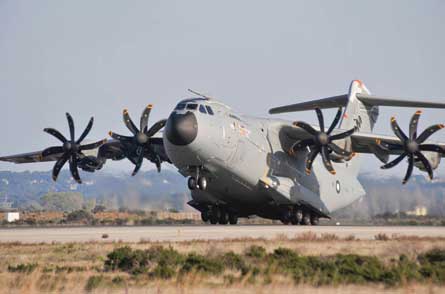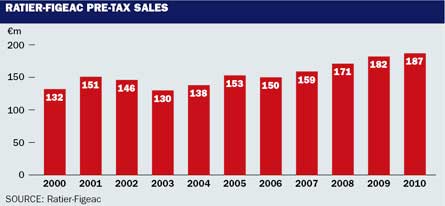Slicing the air as they haul the Airbus Military A400M into flight, the 5.3m (17.5ft)-diameter counter-rotating propellers of the Europrop International TP400-D6 - the West's most powerful turboprop engine - are one of the military transport's most distinctive features.
The 107-year-old French company behind them - Ratier-Figeac - is counting on the European airlifter to help propel its fortunes over the next decade. With the recently type certificated three-shaft, 8,200kW (11,000 shaft horsepower) engine due to start series production later this year ahead of the A400M's entry into service with the French air force in early 2013, the Hamilton Sundstrand subsidiary is gearing up for full-scale production of the eight-bladed propeller system.
The next 36 months will be busy ones for the FH386 line. With 32 of the all-composite blades per aircraft, the company - based in the picture-postcard south-western town of Figeac - expects to be delivering three shipsets next year, followed by nine in 2013, ramping up to 17 and 25 in the following two years. A total of 174 A400Ms are on order from the seven programme-funding European nations and sole export customer Malaysia.
"Everything is in place," says Ratier-Figeac general manager Michel Ferey as he guides Flight International through the company's 52,000m2 (560,000ft2) site where the carbon spar and composite shell propeller systems are among several product lines in manufacture. "We are proceeding without major difficulties."
Despite a historical portfolio that includes aircraft, rally cars and motorcycles, propellers are what Ratier-Figeac is best known for. The company has been designing them since 1908, the forests around Figeac providing a steady supply of timber. Today made from resin transfer-moulded composites rather than wood, they represent 42% of its turnover, split equally between military and civil programmes. As well as the A400M's FH386, the company makes the NP2000 for the Northrop Grumman E-2C Hawkeye surveillance aircraft and the 568F for the ATR 72/42 and the Airbus Military C295 maritime patrol aircraft, among others.
 |
|---|
© Airbus Military |
Ratier-Figeac is well-represented on the A400M |
The business was given a boost in 2007 when Hamilton Sundstrand, whose United Technologies parent acquired Ratier-Figeac in 1998, shifted all propeller manufacturing, including US military programmes, to the French site. Engineering and programme management is shared between Figeac and Hamilton Sundstrand's headquarters in Windsor Locks, Connecticut, with Ferey responsible for the global propeller business as well as running the Figeac operation.
A further third of the company's revenues come from the less-visible cockpit and cabin equipment sector, including products such as door dampeners, engine throttles, side-sticks and rotor brakes. Ten per cent is accounted for by trimmable horizontal stabiliser actuators - it supplies the A400M and Airbus A380 - with a further 9% comprising built-to-print machining of helicopter parts such as tail rotor shafts for AgustaWestland and Eurocopter.
With responsibility for the A400M's throttle control, all three main segments of Ratier-Figeac's manufacturing business are represented on the airlifter. The company is also well positioned on other development programmes, with equipment on the Airbus A350 and Bombardier Learjet 85 and CSeries. It has won contracts on the C919 narrowbody being developed by China's Comac and the Russian United Aircraft MS-21.
 |
|---|
With just under 1,000 employees and revenues which have been rising steadily since 2006 to €187 million ($269 million) last year, Ratier-Figeac is the largest industrial employer in the rural departement of Lot, although the town itself, which has a population of around 10,000, is also home to aerostructures specialist Figeac Aero, with a workforce of 550. Despite Figeac's remoteness - on the edge of a nature park and 2h drive from Toulouse - Ferey does not find it too hard to recruit engineers and other specialists. "Toulouse is a major centre for aerospace and many people enjoy coming here from there because you can buy a bigger house and enjoy a certain quality of life," he says.
But although Ratier-Figeac's workforce has hovered fairly consistently around the 1,000 mark for the past decade, Ferey admits that being such a key employer in a small community otherwise largely dependent on agriculture and tourism can make him feel very exposed. "When you are doing well you are a hero," he says. "But when things are tougher, you are the villain."
Source: Flight International



















